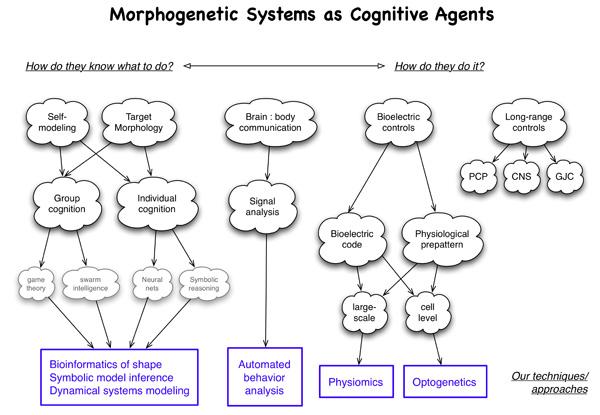Direction of Lab
Our latest efforts fall into 3 lines:
-
Synthetic biology applications of bioelectricity
- a new toolbox for cellular control - biophysical and genetic modules to enable synthetic morphology via controlled ion flows
- software with which to model the storage of patterning information in physiological networks
- patterning tissues as excitable media; computational non-neural tissues
- self-organizing patterns of physiological state among cell fields that does not require protein/mRNA change
- cracking the pattern of bioelectric code to develop a pipeline of computational transforms that extracts target morphology information from voltage dye measurement data (as cognitive content can be extracted from electrical measurements of human brains)
-
Development of a bioinformatics of shape
- Artificial intelligence tools for discovery and testing of algorithmic models linking molecular-genetic data to morphogenesis
Orchestration of the activity of billions of cells into the formation of tissues, organs, and whole bodies does not stop at embryogenesis. In adulthood, even though all cells eventually get replaced, the whole structure keeps a coherent shape for up to 2 centuries (e.g., tortoises). Moreover, some creatures are able to regenerate large parts of their body; for example, salamanders can re-grow entire lost limbs. Thus, living systems constantly monitor their shape for deviations and often can initiate processes to correct the damage and thus restore their "target morphology". These properties are not only of central importance to the fundamental understanding of embryogenesis, regeneration, cancer, and evolution, but are also crucial outside of biology: cybernetics, complexity theory, control theory, and engineering would benefit greatly from an understanding of how such complex, robust, and self-regulating machines can be designed and built. Robots that sensed (and repaired) damage would have immense scientific impact in space exploration, nanotechnology, and other areas where highly adaptive, massively parallel control algorithms are needed. Interestingly, although we are learning ever more about molecular pathways, we still know very little about how living systems regulate and remodel large-scale shape.
Current efforts are largely dominated by the molecular genetic approach. We are rapidly acquiring an immense amount of detail about which gene products interact with which other gene products. We also have functional experiments (inactivate gene A, or introduce gene product B in some region, and see a change in patterning of some organ); from these biologists derive models of control signals propagated among cells that direct their behavior and thus control patterning. While data grow exponentially, true insight into shape generation and repair is significantly impaired because bioinformatics is focused on gene sequences but not applicable to analyses of shape. Thus, several fields are stymied by a lack of conceptual and computerized tools to link mechanistic understanding of molecular signals with behavior of the patterning systems they encode. The field is missing (1) convenient symbolic mathematical tools with which to formalize shape and changes in shape, such that the outcomes of patterning experiments can be stored in a searchable database (like Entrez at NCBI, but for morphogenesis instead of gene expression), (2) generally-accessible agent-based virtual environments within which mechanistic models of patterning can be simulated in silico and integrated with existing data for testing and derivation of key regulatory properties, and (3) accessible artificial intelligence tools to help discover models consistent with experimental results in fields where the data are so abundant and complex that scientists cannot invent models consistent with empirical data.
We are using the data on genetic and bioelectrical mechanisms of regeneration in planarian flatworms (a very popular model system for molecular genetics work) as a proof-of-principle to 1) create a prototype for a symbolic mathematical formalism for encoding knowledge about shape, 2) implement a computing platform (expert system on planarian regeneration) so that anyone can query the existing literature for information about functional experiments that modify morphology, 3) produce a flexible and easy-to-use system for modeling the patterning consequences of control networks including both biochemical and physiological mechanisms, 4) create an Artificial Intelligence tool to assist users to discover mechanistic, constructivist models of signaling among components that match sets of functional data on patterning pathways, 5) use this system to identify a model explaining some of the remarkable regenerative abilities of planarian worms, which can regenerate any part of their body regardless of how they are cut, and 6) experimentally test new predictions of the models we identify in this way. Our work is yielding conceptual modeling and automated mining tools to revolutionize the building of algorithmic, understandable models directly from functional data that are too difficult to discover manually, thus impacting many fields of biology and engineering.
- Artificial intelligence tools for discovery and testing of algorithmic models linking molecular-genetic data to morphogenesis
-
Using techniques from artificial intelligence, computational neuroscience, and cognitive science to make models of morphogenesis - treating patterning systems as primitive cognitive agents
- Modeling pattern formation and cell regulation as neural-like circuits with plasticity, memory, and goal satisfaction circuits; using modulation of global neurotransmitter and electrical synapse properties to write pattern memories and behavioral repertoires into living tissue
- Constructing quantitative models of patterning using extremal (least-action) principles
